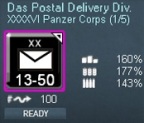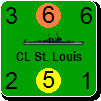bednarre
Posts: 128
Joined: 2/23/2011
Status: offline

|
This is my first post, so wish me luck.
In regard to play balance, someone should set up a Dec 5, 1941 scenario and play that head-to-head with various users and then compare to historical results in regard to losses, frost bite cases, etc.
The following points are relevant:
1) The Germans could not dig foxholes/trenches (Level 1 forts?) in the winter in Russia.
The the ground was frozen solid.
Thus the German Army was not destroyed in December 1941 because of a lack of fortifications.
2) The German Army did suffer massive frost bite cases, but this was without fortifications, which should have dramatically
reduced them.
Read accounts of the Battle of the Bulge in winter 1944. Attacking and thus coming out in the open
resulted in frostbite cases, but the Armerican troops tried to build shelters at all times in defensive positions.
3) In regards to relating the Level of the fortications with actual fortification types, there are alot of questions in my mind.
Military fortications start with foxholes, then trenches, proceeding to wooden cover, concrete bunkers covering just a small amount of the units coverage, and finally proceeding to the infamous Maginot Line type. Why don't all units go to the last type? It takes a great deal of time, manpower, and scare resources as one progresses farther up the fortification latter. While foxholes (generally) only require a few hours and a shovel, the Maginot Line took years to construct and was never finished due to its expense. In Italy there were only two concrete fortification lines built, and the difficulty in supplying attacking troops in the mountains there was the biggest problem. Now imagine trying to create a bunker fortication line over a thousand mile front (or longer if not in multiple lines) which has some operational impact on the attacker. Estimating one bunker every 1000 yards, thats about 2000 bunkers per line. If an engineering company could complete each in 1 month, it would take about 75 "engineer divisions" to complete the task in 4 game turns (per line)! Even wooden cover over this frontage would require a tremendous amount of wood, only practical in a forested area. But even if acheived, the line could be penetrated in a few key places (especially in rough, forested, or urban areas) and the line rendered useless. 75+ divisions would have been wasted, a not small force even for the Russians.
4) So how did the German army survive?
The key were villages, small towns, and Russian supply. The Germans would hold the first two with FANATICAL zeal since a loss meant enduring the bitter cold. The Russians did like wise. There is ony story of a Russian unit to failed to do so, and was stiff the next morning. The Russians would generally fail taking these "strong points" since they tended to attack in mass out in the open, and working German MGs took a stiff toll. The Russians then proceeded to bypass them and go farther down the roads/trails. The problem was the Russian carts and trucks could not move off the roads, and thus re-supply was very limited. The Russian attack fizziled dramatically at this point. Thus the Russians penetrated deep into the German rear areas, the Germans held the town (center of the hex), and the Russian became un-supplied. In the winter, not getting updates to rations every day is worse than running out of ammo or fuel. In game terms, this can only be easily simulated by reducing the probability of the German unit vacating the hex and dramatically reducing the Russian unit supply rate.
5) The increase in Russian CV is very interesting.
Other games tend to give the Russians more CV compared to the German CV in the 1941 frame. WitE tends to model the ratio closer to the War in the East SPI game. This allows early campaign overruns and rapid territory advancement. To over come this, SPI changed to a different combat results table in the winter (not really a good idea). WitE both increases the Russian CV and reduces the Germain CV, both by more than a factor of 2, in winter. Perhaps the designers should consider some type of command and control limitation on the Russian Army and bring the CV ratios closer together (including the winter). It seems the game is overly concerned with the "integer" odds in an attack, instead of the exchange of weaponry. The chess like control of wargaming armies leads to excessive casualty prediction compared with reality.
6) Has anyone tried mimicking Stalin's 1941 mistakes and seeing how the campaign progresses?
I am assuming the actual German generals are well represented by a player, but anticipate that the results will be an easy axis victory. But it was not! This may be another reason for reducing the German/Russian CV ratio. On the other hand, a re-tuned combat result system would also tone down the German losses in the winter.
_____________________________
Reginald E. Bednar
|
 Printable Version
Printable Version
















 New Messages
New Messages No New Messages
No New Messages Hot Topic w/ New Messages
Hot Topic w/ New Messages Hot Topic w/o New Messages
Hot Topic w/o New Messages Locked w/ New Messages
Locked w/ New Messages Locked w/o New Messages
Locked w/o New Messages Post New Thread
Post New Thread